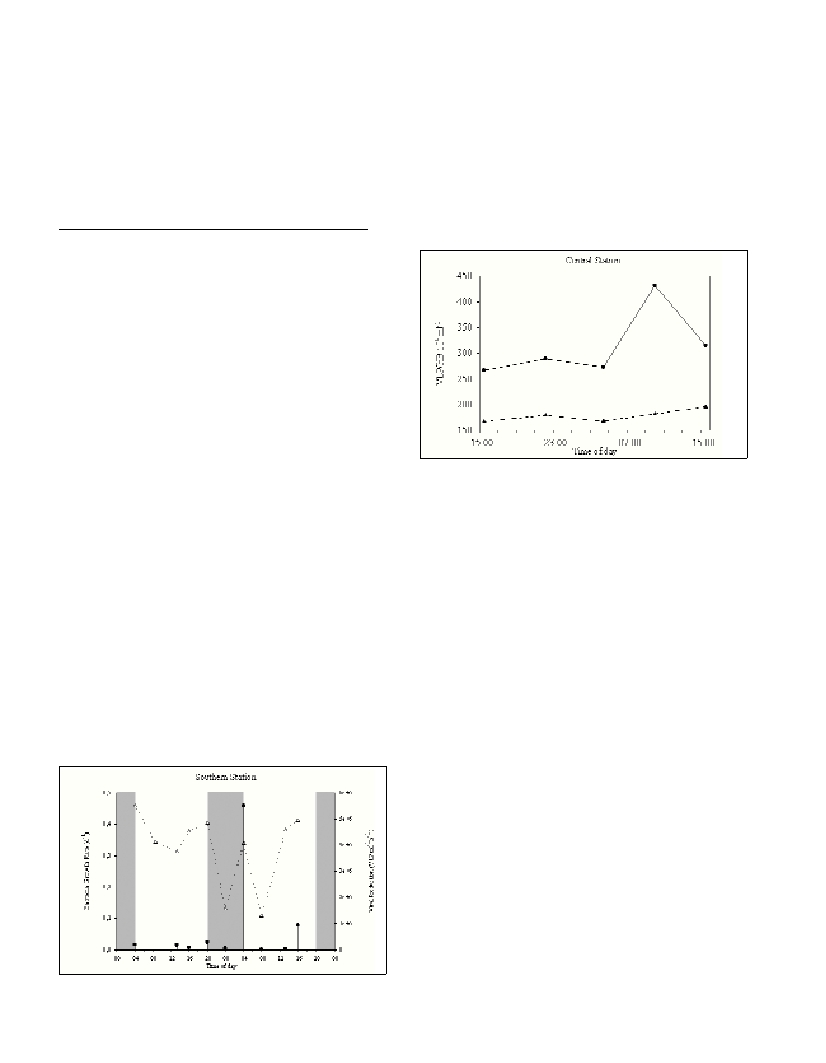Rapp. Comm. int. Mer Médit., 37,2004
283
DIEL DYNAMICS IN VIRIOPLANKTON ACTIVITY
Verónica Parada*, Eva Sintes and Gerhard Herndl
Department of Biological Oceanography, Netherlands Institute for Sea Research (NIOZ),
P.O.Box 59, 1790 AB Den Burg, Texel, The Netherlands - * vparada@nioz.nl
Abstract
Changes in resources availability can in?uence the production of bacteria at a diel scale and might consequently also generate short-term
modifications in viral lysis rates. We examined the diel changes of viral production every 4-8 h in relation to bacteria activity in three water
masses of the North Sea during July 2003. Viral activity was highest at all stations during dawn, ranging from 7.7x10
5
ml
-1
h
-1
to 55.1x10
5
ml
-1
h
-1
but did not follow the dynamics in bacterial production. The results indicate that viral lysis does not exhibit pronounced diel
dynamics in the North Sea.
Key words: viral production, bacterial growth rate, diel cycle
Introduction
Recognition of viruses as the most abundant component of aquatic
microbial communities has generated scientific interest focusing on
their impact on the dynamics of host communities. Diel patterns in
planktonic activity might be re?ected in associated dynamics of the
respective viral component, however, this has not be investigated yet
[1, 2]. While bacterioplankton abundance and biomass remain usually
fairly stable, their activity changes at a scale of hours [3, 4]. As viral
production depends on bacterial activity, we hypothesized that diel
dynamics in bacterial production should be re?ected in short-term
changes of viral lysis.
Materials and Methods
We sampled surface waters of the North Sea at three drifting
stations during summer (July 2003) every 4-8 h for a total period of
28-48 h. Viral production was estimated using the virus-dilution
approach [5, 6]. Bacterial activity was measured via [
14
C]-leucine
incorporation. Bacterial and viral abundance was determined in
duplicate by ?ow cytometry.
Results and conclusion
Viral abundance averaged 21x10
7
ml
-1
at the southern station,
10x10
7
ml
-1
at the central station and 8x10
7
ml
-1
at the northern
station of the North Sea. Viral abundance displayed short-term
oscillations but not a diel trend. Viral production ranged from 1.8x10
4
to 5.5x10
6
ml
-1
h
-1
at the southern station (Fig. 1), from 7.7x10
3
to
1.0x10
6
ml
-1
h
-1
at the central station (Fig. 2) and from 6.4x10
4
to
3.3x10
5
ml
-1
h
-1
at the northern station. The highest values of viral
lysis were recorded around dawn in all the stations.
The range of bacterial abundance and activity, respectively, was
5.9x10
5
ml
-1
and 0.94 -3.1 nmol Leu l
-1
d
-1
at the southern station,
4.6x10
5
ml
-1
and0.13-1.63 nmol Leu l
-1
d
-1
at the central station and
3.0x10
5
ml
-1
and 0.85-1.33 nmol Leu l
-1
d
-1
at the northern station.
Bacterial activity was slightly lower during the night in all the
stations. Bacterial growth rate was 0.11-0.46 d
-1
at the southern
station (Fig.1), 0.06-0.24 d
-1
at the central station and 0.20-0.34 d
-1
at
the northern station.
Pronounced diel dynamics in the viral activity were not detectable,
probably due to the low diel dynamics in bacterial activity in the
mesotrophic North Sea. More pronounced diel patterns in
bacterioplankton growth has been reported for oligotrophic systems
such as the Mediterranean Sea.
Fig. 1. Dynamics of bacterial growth rates (triangles) and viral
production (circles) at the Southern Station of the North Sea.
Fig. 2. Dynamics of virus like particles (VLP, circles) and heterotrophic
bacterial (HB) abundance during incubation of water from 13:15 h at the
Central station.
References
1-Suttle, C.A., 1994. The significance of viruses to mortality in aquatic
microbial communities. Microb. Ecol., 28: 237-243.
2-Wommack, K.E. and Colwell, R.R., 2000. Virioplankton: viruses in
aquatic ecosystems. Microbiol. Mol. BioI. Rev., 64: 52 69-114.
3-Lenski, R.E., 1988. Dynamics of interactions between bacteria and
virulent bacteriophage. Adv. Microb. Ecol., 10: 1-44.
4-Steward GF, Wikner J, Cochlan WP, Smith DC, Azam F., 1992.
Estimation of virus production in the sea: 2. Field results. Marine
Microbial Food Webs, 6:79-90.
5-Wilhelm, S.W. and Suttle, C.A., 1999. Viruses and nutrient cycles in
the Sea. Bioscience, 49: 781-788.
6-Weinbauer, M., Winter, C. and Ho?e, M., 2002. Reconsidering
transmission electron microscopy based estimates of viral infection of
bacterioplankton using conversion factors derived from natural
communities. Aquat. Microb. Ecol., 27: 103-110.

